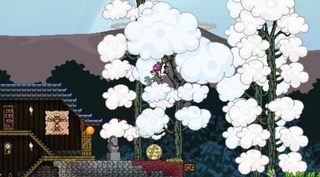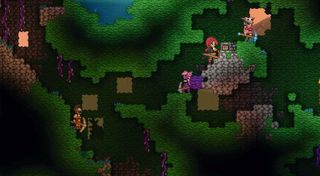How Starbound plans to break down the lines between player and game designer

In order to encourage modding, future versions of Starbound will enable server admins to specify mods to be downloaded automatically when players connect to a multiplayer universe. This allows for substantial changes to be made without players needing to download lots of files in advance. It's part of a general effort that Chucklefish are making to turn Starbound into a platform as much as a game—a way of creating adventures for other players to go on.
Modding has a role to play in making that a reality, but in-game tools are also a priority. On the list are player-made missions: dungeons or quests that can be built within the game itself then pulled out and distributed as standalone challenges. Using simple logic devices, players will be able to create monster spawners, signposts, and so on. Just as the structure of Starbound as a whole is inspired by console platformers like Metroid and Castlevania, so will players be able to create and distribute their own Metroidvania-style games. These might be fixtures on specific servers, downloads, or instances that players can jump to via the in-game starmap.
Then there's Director Mode. This will be a separate version of the game that lets any player with the right admin access act as a game master on a given server. They'll have a great deal of power to create environments and NPCs – they can even control any NPC directly to speak with players or provide a more challenging combat encounter. If you played Neverwinter Nights in multiplayer, you'll have a sense of what Chucklefish are trying to achieve here.
“There's this problem with storytelling in games,” says Tiyuri. “One of the first game I saw trying to do this was Sleep is Death.”

Sleep is Death was Jason Rohrer's experimental multiplayer storytelling game, where one player manipulated the game environment to tell a cooperative story with another.
“It was a great concept and when it worked, it worked incredibly well. It worked so well that some people came away saying that it was the future of gaming. But one of the things I think that stopped it taking off was that the amount of preparation required was so high—it was a real struggle to be the person telling the story.”
“There's also a problem if the person who's telling the story leaves the computer,” Tiyuri continues. “Everything grinds to a halt. So we thought we'd do something similar, but we'd tie it into an existing world and do so in a way that's completely and utterly transparent.”
The biggest gaming news, reviews and hardware deals
Keep up to date with the most important stories and the best deals, as picked by the PC Gamer team.
Starbound's existing game logic can be used to make a director's job easier. If they go offline or shift their focus, the AI can take over the characters that they leave behind. Likewise, the same procedural generation technology and progression structures that exist in the regular game will provide things to do when a director isn't present to tell a hand-crafted story.

“You can do as much or as little as you want without ruining the experience,” Tiyuri says. “If I wanted, I could control just one enemy, and, er, have a really annoying enemy.”
The future that Tiyuri envisions for the game is one where individual Starbound servers will have their own character and their own stories, combining modding, mission design and hands-on directorship to create as many versions of Starbound as there are players willing to work on them.
Both halves of Starbound's ancestry—traditional modding scenes on one hand, creative, freeform games such as Minecraft and Garry's Mod on the other—suggest that this plan will be a success. There are more creative people in the world than there are games that furnish them with the tools to be creative. As with any community effort, however, the biggest rewards will go to the players who actively seek out these experiences and involve themselves in the scene.
I've no doubt that Starbound will be something special to the people who are in the right position to appreciate the way all of these ambitious systems work together.
I wonder, however, about the experience for players who only tap away at the surface—without digging any deeper. In particular, I was keen to ask if Tiyuri had any concerns that players would simply use these creative tools to short-circuit the game's progression systems.

“To solve that problem, you have to cut out a huge amount of functionality,” he tells me. “So it's not something we're going to worry about, honestly.”
Chucklefish trust players to choose the experience that's right for them. This is an admirable stance, even if it does mean that a certain percentage of players will use the tools available to cheat. A similar logic applies to server admins who abuse their powers at the expense of visitors to their domains.
“It's up to you to provide an experience that people want to have on your server,” Tiyuri says. “If you're messing around and making it unfair, it's likely that people aren't going to want to stay. I'm sure that some people will go above and beyond in making their server an amazing place to be.”
All of these creative features take on additional meaning when applied to Sector X, Starbound's forthcoming player vs player sector. “The PvP experience we're going for isn't all that much about combat, really,” Tiyuri says. “We're going for a DayZ-like experience. I'm not sure anybody plays DayZ for the quality of the shooting—it's all about decision making.”
Players that choose to set up a farmstead in Sector X will do so in the knowledge that they're under threat from other players, and how they negotiate this situation will be informed by all of the creative tools at their disposal—including, potentially, the role of a director or team of directors. It's a promising system, although Tiyuri acknowledges that combat needs a few changes for PvP to operate optimally.

“Combat is slightly underdeveloped right now,” he says. “It's going to be much more robust, and that bleeds into PvP.” This means multiple ways to use individual weapons, in particular, as well as reworked shields and spears.
I asked Tiyuri if getting Starbound to the point where it is essentially player-run would mark the end of Chucklefish's involvement in their flagship game.
“It'll be a big part of what we're doing for a long time,” he says. “It's going to take a year to even finish the game, I imagine, and after that we're going to support it for a long time. Eventually, when we do want to move on from it, I don't think it'd be difficult to pick people from the community to update the game in an official capacity. I'd like to give the community a lot of control once it's reached that stage. In the meantime, I think there's a lot to be said for having a central body managing the project.”
The notion that members of Starbound's current community could become the game's official curators in a few years feels like a logical—and philosophically apt—future for the game. But that future is a way off yet.
“I don't think I'm ever not going to want to be involved in some way,” Tiyuri says. “When we hit version one, it'll be the game we planned to make – but by that time we'll have so many more things we could add to it. It's a game with so much scope that it's almost difficult to get away from.”
Joining in 2011, Chris made his start with PC Gamer turning beautiful trees into magazines, first as a writer and later as deputy editor. Once PCG's reluctant MMO champion , his discovery of Dota 2 in 2012 led him to much darker, stranger places. In 2015, Chris became the editor of PC Gamer Pro, overseeing our online coverage of competitive gaming and esports. He left in 2017, and can be now found making games and recording the Crate & Crowbar podcast.
Most Popular



